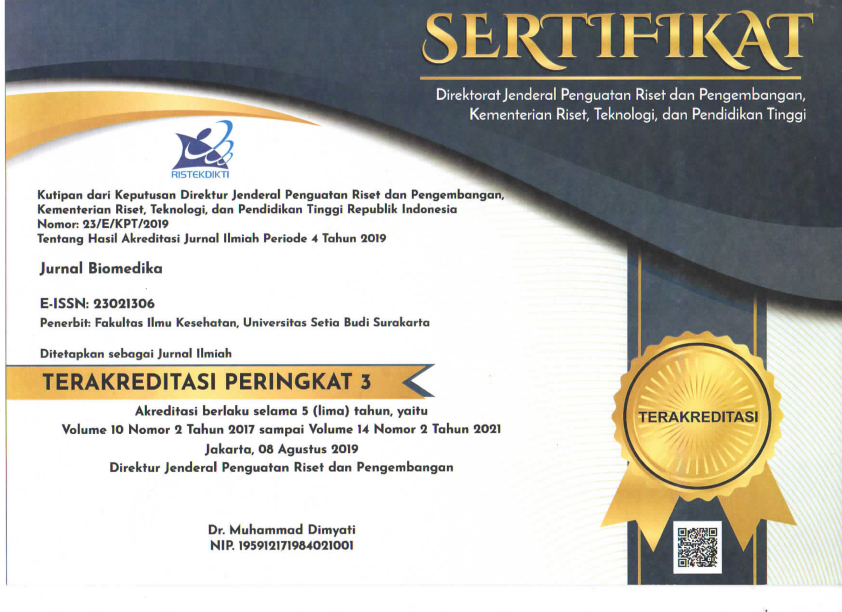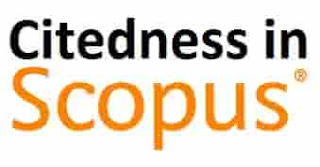Anti-fungal Activity Test Ethanolic Extracts of Calabash's Leaved and Fruit Meat (Crescentia cujete, Linn.) against Candida albicans ATCC 1023
Abstract
Candida albicans is the cause of opportunistic candidiasis which is a fungal infection with the highest incidence. Candidiasis is a disease that can attack the oral cavity, mucous membranes, and genital areas. Indonesia is a country that is rich in biodiversity and people have used more than 6,000 species of plants as medicines and protection needs. One of the herbs that can be used as an alternative treatment for candidiasis is Calabash (Crescentia cujete, Linn.) Which has not been much studied. Throwing contains alkaloids, flavonoids, phenols and tannins which can damage the cell wall of Candida albicans. The purpose of this study was to determine the antifungal activity of leaves and fruit of Calabash (Crescentia cujete, Linn) against Candida albicans ATCC 1023 and determine the maximum concentration as an antifungal. This research is an experimental laboratory research. The test method used is the disk diffusion method. The extraction method used is ethanol maceration. The results showed that the leaves and fruit of Calabash had an antifungal activity against Candida albicans ATCC 1023. The maximum concentration of the extracts of the Calabash was 25% with inhibition zone diameters of 15 ± 0.8 mm and 9.33 ± 0, 57 mm.
References
Ardianti, A., Kusnadi, J. 2014. Ekstraksi Antibakteri dari Daun Berenuk (Crescentia cujete Linn.) Menggunakan Metode Ultrasonik. Jurnal Pangan dan Agroindustri, Vol.2 (2) p.28-53.
Ariningsih, R. I. 2009. Isolasi Streptomyces dari Rizosfer Familia Poaceae Yang Berpotensi Menghasilkan Antijamur Terhadap Candida albicans. Surakarta. Universitas Muhammadiyah Surakarta.
Atmoko, T dan Ma’ruf, A. 2009. Uji Toksisitas dan Skrining Fitokimia Ekstrak Tumbuhan Sumber Pakan Orangutan Terhadap Larva Artemia salina L. Jurnal Penelitian dan Konservasi Alam, 6(1): 37-45
Bahroni dan Istianah. 2018. Pemanfaatan Buah Berenuk (Crescentia cujete Linn.) Sebagai Bahan Baku Pembuatan Bioetanol. Jakarta. Universitas Islam Negeri Syarif Hidayatullah Jakarta.
Bruno, M ,Mignogna, G, Angiolella, L. 2015. Resistance in Candida albicans: Exploring The Cell Wall Barrier by Proteomics. Chemo Open Acces 4, pp: 165. Departemen Kesehatan Republik Indonesia. 1979. Farmakope Indonesia. Edisi Ketiga.
Departemen Kesehatan Republik Indonesia. 1979. Farmakope Indonesia. Edisi Ketiga.
Departemen Kesehatan Republik Indonesia. 2000. Parameter Standar Umum Ekstrak Tumbuhan Obat. Jakarta.
Gupta, C. Garg, A. P. Gupta, S. 2010. Antimicrobial and Phytochemical Studies of Fresh Ripe Pulp and Dried Unripe Pulp of Mangifera indica (AMCHUR). Middle-East Journal of Scientific Research, 5(2):75-80.
Irianto, K. 2014. Bakteriologi, Mikologi, dan Virologi. Panduan Medis dan Klinis. Bandung: Penerbit Alfabeta. Jawetz, E. J. Melnick, J. L & Adelberg, E. A. 2005. Mikrobiologi Kedokteran. Jakarta: EGC.
Jawetz, E. J. Melnick, J. L & Adelberg, E. A. 2005. Mikrobiologi Kedokteran. Jakarta: EGC.
Kaneko, T., Ohtani, K., Kasai, R., Yamasaki, K., Minh Duc, N. 1998. n-Alkylglycosides and p-Hydroxybenzoyloxy Glucose from Fruits of Crescentia cujete. Phytochemistry 47(2):259-263. DOI: 10.1016/S0031-9422(97)00409-3.
Kusuma, M. A. Sulistyo, N. A. Susanti & Sabikis. 2014. Aktivitas Pengehntian Pendarahan Luar Ekstrak Etanol Daun Berenuk (Crescentia cuejet, Linn.) Secara In-Vivo. Pharm Sci Res. Vol. 1, No.2.
Mahbub, K. R., Hoq, M. M., Ahmed, M. M., & Sarker, A. 2011. In Vitro Antibacterial Activity of Crescentia cujete and Moringa oleifera. Bangladesh Research Publication Journal Vol. 5(4), 337-43.
Parvin, M. S., Das, N., Akhter, M. A., Nahar, L., Islam, M. E. 2015. Evaluation of In Vitro Anti-Inflammatory and Antibacterial Potential of Crescentia cujete Leaves and Stem Bark. BMC Research Notes 8:412-418. DOI: 10.1186/s l 3104-015-1384-5.
Poonam S, Hardeep S., Patrick, R.C., Kang, M.H. 2013. Defining The Metabolic Pathways of 13-Cis Retinoic Acid. Dalam: Proccedingsof the 104th Acctual Meeting of he American Association for Cancer Research.
Rifai, M. 1994. A Discourse on Biodiversity Utilisation in Indonesia. Dalam Tropical Biodiversity. YABSHI, Jakarta: 348 - 351.
Rintiswati, N., Winarsih, N.E., & Malueka, R.G. 2004. Potensi Antikandida Ekstrak Madu secara in Vitro dan in Vivo. Berkala Ilmu Kedokteran. 36(4): 187-94.
Saifudin, A. 2011. Standardisasi Bahan Obat Alam. Yogyakarta: Graha Imu. Pp. 1-11.
Siregar, R.S. 2005. Atlas Berwarna Saripati Penyakit Kulit: Kandidiasis.Edisi 2. Jakarta: EGC. pp. 31-5.
Soetojo, S.D.R and Astari, L. 2016. Profile of New Patient with Candida Infection in Skin and Nail. Jurnal Berkala Ilmu Kesehatan Kulit dan Kelamin. Vol.28. No.1.
Sudoyo, A. W. 2009. Buku Ajar Ilmu Penyakit Dalam, jilid II, edisi V.Jakarta: Interna Publishing.























